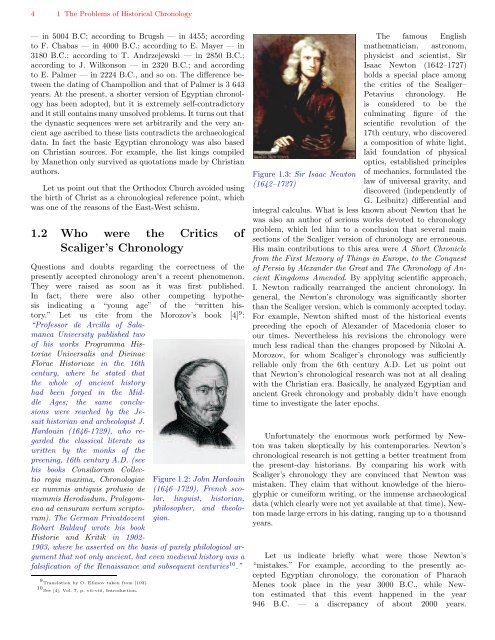mysteries of egyptian zodiacs - HiddenMysteries Information Central
mysteries of egyptian zodiacs - HiddenMysteries Information Central
mysteries of egyptian zodiacs - HiddenMysteries Information Central
Create successful ePaper yourself
Turn your PDF publications into a flip-book with our unique Google optimized e-Paper software.
4 1 The Problems <strong>of</strong> Historical Chronology<br />
— in 5004 B.C; according to Brugsh — in 4455; according<br />
to F. Chabas — in 4000 B.C.; according to E. Mayer — in<br />
3180 B.C.; according to T. Andrzejewski — in 2850 B.C.;<br />
according to J. Wilkonson — in 2320 B.C.; and according<br />
to E. Palmer — in 2224 B.C., and so on. The difference between<br />
the dating <strong>of</strong> Champollion and that <strong>of</strong> Palmer is 3 643<br />
years. At the present, a shorter version <strong>of</strong> Egyptian chronology<br />
has been adopted, but it is extremely self-contradictory<br />
and it still contains many unsolved problems. It turns out that<br />
the dynastic sequences were set arbitrarily and the very ancient<br />
age ascribed to these lists contradicts the archaeological<br />
data. In fact the basic Egyptian chronology was also based<br />
on Christian sources. For example, the list kings compiled<br />
by Manethon only survived as quotations made by Christian<br />
authors.<br />
Let us point out that the Orthodox Church avoided using<br />
the birth <strong>of</strong> Christ as a chronological reference point, which<br />
was one <strong>of</strong> the reasons <strong>of</strong> the East-West schism.<br />
1.2 Who were the Critics <strong>of</strong><br />
Scaliger’s Chronology<br />
Questions and doubts regarding the correctness <strong>of</strong> the<br />
presently accepted chronology aren’t a recent phenomenon.<br />
They were raised as soon as it was first published.<br />
In fact, there were also other competing hypothesis<br />
indicating a “young age” <strong>of</strong> the “written his-<br />
tory.” Let us cite from the Morozov’s book [4] 9 :<br />
“Pr<strong>of</strong>essor de Arcilla <strong>of</strong> Salamanca<br />
University published two<br />
<strong>of</strong> his works Programma Historiae<br />
Universalis and Divinae<br />
Florae Historicae in the 16th<br />
century, where he stated that<br />
the whole <strong>of</strong> ancient history<br />
had been forged in the Middle<br />
Ages; the same conclusions<br />
were reached by the Jesuit<br />
historian and archeologist J.<br />
Hardouin (1646-1729), who regarded<br />
the classical literate as<br />
written by the monks <strong>of</strong> the<br />
preening, 16th century A.D. (see<br />
his books Consiliorum Collectio<br />
regia maxima, Chronologiae<br />
ex nummis antiquis prolusio de<br />
mummis Herodiadum, Prolegomena<br />
ad censuram vertum scriptorum).<br />
The German Privatdozent<br />
Robart Baldauf wrote his book<br />
Historie und Kritik in 1902-<br />
Figure 1.2: John Hardouin<br />
(1646–1729), French scolar,<br />
linguist, historian,<br />
philosopher, and theologian.<br />
1903, where he asserted on the basis <strong>of</strong> purely philological argument<br />
that not only ancient, but even medieval history was a<br />
falsification <strong>of</strong> the Renaissance and subsequent centuries 10 .”<br />
9 Translation by O. Efimov taken from [103].<br />
10 See [4], Vol. 7, p. vii-viii, Introduction.<br />
Figure 1.3: Sir Isaac Newton<br />
(1642–1727)<br />
The famous English<br />
mathematician, astronom,<br />
physicist and scientist, Sir<br />
Isaac Newton (1642–1727)<br />
holds a special place among<br />
the critics <strong>of</strong> the Scaliger–<br />
Petavius chronology. He<br />
is considered to be the<br />
culminating figure <strong>of</strong> the<br />
scientific revolution <strong>of</strong> the<br />
17th century, who discovered<br />
a composition <strong>of</strong> white light,<br />
laid foundation <strong>of</strong> physical<br />
optics, established principles<br />
<strong>of</strong> mechanics, formulated the<br />
law <strong>of</strong> universal gravity, and<br />
discovered (independently <strong>of</strong><br />
G. Leibnitz) differential and<br />
integral calculus. What is less known about Newton that he<br />
was also an author <strong>of</strong> serious works devoted to chronology<br />
problem, which led him to a conclusion that several main<br />
sections <strong>of</strong> the Scaliger version <strong>of</strong> chronology are erroneous.<br />
His main contributions to this area were A Short Chronicle<br />
from the First Memory <strong>of</strong> Things in Europe, to the Conquest<br />
<strong>of</strong> Persia by Alexander the Great and The Chronology <strong>of</strong> Ancient<br />
Kingdoms Amended. By applying scientific approach,<br />
I. Newton radically rearranged the ancient chronology. In<br />
general, the Newton’s chronology was significantly shorter<br />
than the Scaliger version, which is commonly accepted today.<br />
For example, Newton shifted most <strong>of</strong> the historical events<br />
preceding the epoch <strong>of</strong> Alexander <strong>of</strong> Macedonia closer to<br />
our times. Nevertheless his revisions the chronology were<br />
much less radical than the changes proposed by Nikolai A.<br />
Morozov, for whom Scaliger’s chronology was sufficiently<br />
reliable only from the 6th century A.D. Let us point out<br />
that Newton’s chronological research was not at all dealing<br />
with the Christian era. Basically, he analyzed Egyptian and<br />
ancient Greek chronology and probably didn’t have enough<br />
time to investigate the later epochs.<br />
Unfortunately the enormous work performed by Newton<br />
was taken skeptically by his contemporaries. Newton’s<br />
chronological research is not getting a better treatment from<br />
the present-day historians. By comparing his work with<br />
Scaliger’s chronology they are convinced that Newton was<br />
mistaken. They claim that without knowledge <strong>of</strong> the hieroglyphic<br />
or cuneiform writing, or the immense archaeological<br />
data (which clearly were not yet available at that time), Newton<br />
made large errors in his dating, ranging up to a thousand<br />
years.<br />
Let us indicate briefly what were those Newton’s<br />
“mistakes.” For example, according to the presently accepted<br />
Egyptian chronology, the coronation <strong>of</strong> Pharaoh<br />
Menes took place in the year 3000 B.C., while Newton<br />
estimated that this event happened in the year<br />
946 B.C. — a discrepancy <strong>of</strong> about 2000 years.



